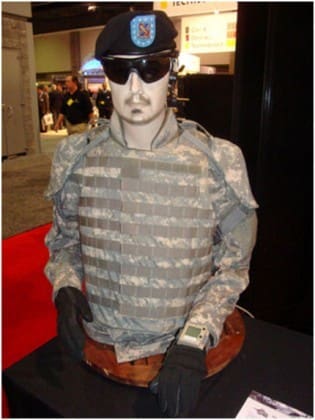“Popular Science” named the Army’s Individual Gunfire Detection program one of the “Best of What’s New 2009.†Interestingly, despite limited field evaluations, it remains a science project while acquisition officials continue to refine the requirement.
One of the two current systems vying for the program is the Boomerang Warrior by BBN Technologies. Cambridge, Massachusetts based BBN Technologies is a 60 year old company instrumental in the development of the first internet routers and has been at the forefront of acoustic analysis for decades. They were recently purchased by Raytheon. Last year BBN acquired Digital Force Technologies. DFT enjoys an excellent reputation in the Tagging, Tracking, and Locating arena and developed the Satellite Imagery Enhanced GPS (SIMEG) Receiver.
In the case of Boomerang Warrior, three pieces of information are provided to the wearer both on a wrist mounted display and via audio cues from a headset; direction of shot (clock method), elevation, and range. BBN claims that Boomerang Warrior experiences less than one percent false alarms and actually detects more than 95% of all super-sonic projectiles. Accuracy is characterized as Range +/- 20%, Bearing < 7.5 Degrees, and Elevation < 7.5 Degrees.
By using the “Clock Method†of reporting information to the Soldier, the information becomes much more subjective and does not need to be nearly as accurate as it is primarily for force protection. Since each hour on the clock covers a 30 degree arc, the system is more than accurate enough for its intended use at 7.5 degrees. An internal electronic compass ensure the cues are relative to the Soldier's current heading. The data may also be shared with battlefield reporting systems such as FBCB2.
The shoulder pads are self contained and essentially redundant. They can each work independently of one another. They give a full 360 degree look at the environment relying on a series of embedded microphones. If both Sensor Pads detect an event the system analyzes both sets of data and presents a solution. Also of note, the sensor pads are not ballistic in nature but rather are compatible with the Army’s issue Deltoid Axillary Protection System (DAPS).
Only a single Boomerang Warrior has been deployed into theater according to BBN. US Army Natick has funded a portion of the development of the Boomerang Warrior system and one year remains on this contract.

Oddly enough, despite funding the development of Boomerang Warrior, the Army seems to be much keener on the QinetiQ North America’s Soldier Wearable Acoustic Targeting System (SWATS). In fact, photos of the IGD system on PEO-Soldier’s website feature a Soldier wearing SWATS. Army G3 directed PEO-Soldier to execute a field evaluation of an Individual Gunfire Detection system and the system chosen was the SWATS. The Capabilities Production Document (CPD) is still in draft and any use at this point should be considered an operational demonstration to ascertain the validity of the technology and to consider Tactics, Techniques, and Procedures development. Based on candidate technical maturity, Product Manager Soldier Sensors and Lasers deployed 12 Soldier SWATS to theater in 2007 for the first user evaluation. This evaluation prompted several changes to the design and functionality. In 2008, 1100 improved SWATS were sent to theater for a second user evaluation. The information gathered during these evaluations is being used in the development of the IGD CPD.
Note that QinetiQ who builds the Army’s preferred solution was formed from the British Defence Evaluation and Research Agency, along the lines of the US DARPA. This is significant because the US essentially abandoned acoustic range and bearing technology as a means to determine characteristics of an incoming projectile in the mid 1980s. At that point, the Army dismantled its acoustic ranging infrastructure, mothballed the equipment, and retrained the Soldiers who specialized in the technique. This was done in favor of the use of RADAR systems such as the AN/TPQ-36 Firefinder. During this period, the British military continued its reliance on acoustic ranging systems and this may account for some of their technical edge.
Current operations renewed US interest in the development of acoustic systems (UTAMS) for the detection initially of mortar and rocket fire due to lower production and operating costs as well as the passive nature of these systems. Along a parallel path, work began on the detection of small arms fire as a means to counter enemy sniper operations. In fact, development of the successful vehicle mounted Boomerang system also built by BBN was funded by DARPA as a lower cost alternative to the French PILAR system. PILAR saw limited use by SOCOM early in the war.
Finally, it is important to note that BBN’s Boomerang vehicle mounted system has been very successful with over 5000 systems fielded so far in theater through Program Manager-Robotics and Unmanned (PM-RUS). The $73.8 million contract calls for a total of 8,131 Boomerang systems including spare parts.


